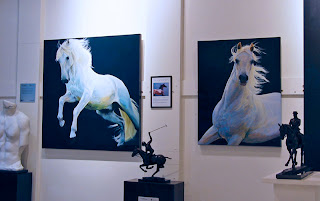Sophie riding Rivaldo of Berkeley
As the 2012 games approach, athletes are working very hard to prepare for representing their country. The time they spend in front of the judges usually only lasts a few minutes, and it is often easy to forget that their performance represents hundreds and hundreds of hours of practice. This is especially true in equestrian sports, such as dressage, where the more polished the performance the easier it can look.
I'm undertaking a portrait of paralympic dressage rider, Sophie Christiansen. Sophie has cerebral palsy, which makes coordination of her limbs and maintaining her balance a real challenge, especially in dressage. Despite the hurdles she must overcome, Sophie has won numerous championships including two gold and one silver medal at the Beijing Paralympics, and a bronze at Athens, at the tender age of 16. I want my portrait to convey the work that Sophie and her coach, Clive Milkins of South Bucks RDA, put into preparing for the 2012 games. But more than this, I plan to portray Sophie as the well rounded person she is, because she is not a professional rider and has to fit training into a very busy life that includes studying for a masters degree at University of London.
I first met Sophie when I went with her mother, Caroline, to the RDA facility in Buckinghamshire. I also met her "ride", the beautiful Oldenburg gelding Rivaldo of Berkeley (Robin). Robin is not "push button", but is a very sensitive soul, as well as being highly intelligent. I asked Clive if the horses at the RDA required special training, and he replied that they need a kind heart and willingness, which certainly seems to describe Robin.
The training session, which took place in the indoor arena, was a fascinating experience. Riding without stirrups, it became very clear just how hard Sophie had to work, juggling maintaining her balance with the physical cues needed to guide Robin. Her perseverance, as well as her absolute honesty about and merciless appraisal of her riding, gave a glimpse of the determination that has made her World Champion. Through a constant dialogue with Clive, she honed her performance over the period of training.
The following Sunday, Caroline, Sophie and I traveled to Dartford for a competition. Sophie mentioned that she was very tired, because there's a lot of work to do in your final year at university. Still, here she was on a Sunday, preparing to compete whilst other students enjoyed a morning in bed and a big breakfast.
Clive took Robin into the outdoor arena to warm him up. At this point we were treated to a display of Robin's moves, with a trot that seemed to float six inches above the ground then moving into an extended trot that was pure grace. Listening to Clive talk, afterwards, it is clear that he dearly loves horses and respects them as individuals, understanding and allowing for their character traits in the work he does with RDA.
After the warmup, we watched Sophie take Robin through his paces, then it was off for the two classes into which Sophie was entered. Watching her ride, her body still and relaxed, her horse going flawlessly through his paces, it became clear just how much determination and skill she brings to her riding. She is a lovely young woman of enormous talent and resolve, and I can only hope that I will be able to convey some small part of this in her portrait.












